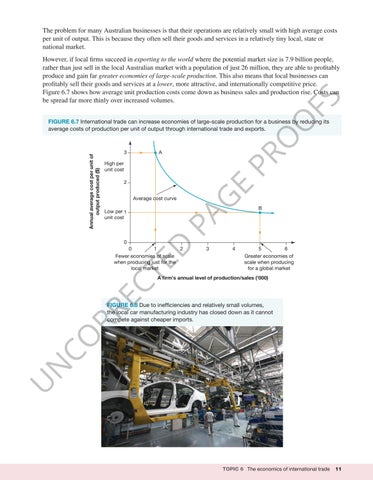“c06TheEconomicsOfInternationalTrade_PrintPDF” — 2022/5/31 — 13:29 — page 11 — #11
The problem for many Australian businesses is that their operations are relatively small with high average costs per unit of output. This is because they often sell their goods and services in a relatively tiny local, state or national market.
O
FS
However, if local firms succeed in exporting to the world where the potential market size is 7.9 billion people, rather than just sell in the local Australian market with a population of just 26 million, they are able to profitably produce and gain far greater economies of large-scale production. This also means that local businesses can profitably sell their goods and services at a lower, more attractive, and internationally competitive price. Figure 6.7 shows how average unit production costs come down as business sales and production rise. Costs can be spread far more thinly over increased volumes.
O PR
A
3 High per unit cost
Average cost curve
0
B
PA
Low per 1 unit cost
G
E
2
D
Annual average cost per unit of output produced ($)
FIGURE 6.7 International trade can increase economies of large-scale production for a business by reducing its average costs of production per unit of output through international trade and exports.
TE
1 2 0 Fewer economies of scale when producing just for the local market
3
4
5 6 Greater economies of scale when producing for a global market
CO RR EC
A firm’s annual level of production/sales (’000)
U
N
FIGURE 6.8 Due to inefficiencies and relatively small volumes, the local car manufacturing industry has closed down as it cannot compete against cheaper imports.
TOPIC 6 The economics of international trade
11





















































